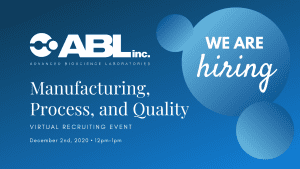
How Do We Actually Meet the Needs of the Evolving Life Science Workforce?
We’ve all heard it – life science jobs are hotter than ever before, but companies are struggling to find the right talent with the right skillset for the role. From entry level positions to manufacturing roles to senior directors, talk to anyone in the biotech and biopharma arena and they will tell you that things are tough right now. The recent slew of layoffs in the wake of a struggling biotech stock market and negative clinical data is the cherry on top of a cake that has been sitting in the display case for far, far too long.
A recent panel discussion at Bisnow’s May Mid-Atlantic Life Sciences & Biotech event further emphasized the point that we’ve been hearing time and time again – we need to do more to support and adequately prepare the workforce to fill not only the current life science positions but future needs as well.
Panelists included:
- Gregory Ball, Ph.D. – Vice President for Research at the University of Maryland, College Park and University of Maryland, Baltimore
- Chandra Briggman – President, Chief Executive Officer at Activation Capital
- Annica Wayman, Ph.D. – Associate Dean for Shady Grove Affairs, University of Maryland Baltimore County
- Amanda Cowley – Senior Vice President and General Counsel at United States Pharmacopeia
- Helen Montag – Senior Director, Ecosystem Development at Johns Hopkins Technology Ventures
- Janna Sircus (Moderator) – Human Resources Generalist at Charles River Laboratories
While there were many topics discussed, a core message rang clear. And the message is unsurprising:
We Need to Rethink the Educational Needs of the Evolving Workforce and How We Evaluate Credentials
Graduate high school. Go to a 4-year university. Earn your Bachelor’s. Join the workforce or go to graduate school if you need additional training for your desired career path. This has been the traditional dogma for decades, and decades ago it worked well.
That’s not the case anymore, though.
You now have people in non-science career paths who were inspired by COVID vaccine efforts and want to now be involved in drug development. Online courses and workshops enable us to learn new skills with the click of a mouse. Community colleges are offering high-quality, hands-on biotech training programs at the fraction of the cost of a traditional 4-year university degree. Advanced degree graduates, from PhDs to MDs, are finding that there are a slew of different career options outside of being an academic scientist or a practicing doctor. You see more and more professionals going back to school to get a specialized degree or certification.
Times are clearly a’changin’ – how can we ensure that both the workforce is adequately prepared to take on these new roles and that employers are seeing and recognizing their potential?
A few thoughts from the panel below:
Employers Must Be Willing to Adapt to the Changing Landscape, No Matter How Unexpected
We’re continuing to beat the long-beaten drug here, but it must be said again – COVID has taken everything we’ve known about work and has turned it on its head. Professors have had to quickly adapt to engaging students in a virtual setting, especially when in-person lab courses were not possible. Employers have had to pivot to evaluating a job candidate’s potential over Zoom. The old notion of the 9-5 has been retired as employees shift around their working hours to accommodate other obligations. And biotech manufacturing has seen a boom like never before, particularly for those developing COVID diagnostics, vaccines, or therapeutics.
Amanda Cowley noted how rather than resist change, USP has embraced this new way of thinking by establishing flexible working hours, setting up facilities with plenty of space to enable distancing, and overall working toward a more inclusive workplace.
As the Great Resignation marches on, we’ve seen in real-time the consequences of those companies who are adamant about returning to a pre-pandemic “normal” – their workforce is leaving in droves, and they’re struggling to fill roles.
Integrate More Cross-talk and Interdisciplinary Training
We hear this often as well – prepare the workforce for the jobs of tomorrow that we don’t know of yet. Unless you have a superpower that lets you look into the future, this is easier said than done. So how do we do this?
Maryland is a research powerhouse, with esteemed universities such as the various University of Maryland campuses and Johns Hopkins University. However, compared to other markets such as Cambridge, Greg Ball noted that local BioHealth Capital Region companies have not tapped into students as Cambridge has with MIT and Harvard.
A key part of Greg’s job is to break down university and industry silos, bridging more connections and cross-talk between universities and local companies. His efforts have already started to pay off – in recent years, more companies have reached out to partner with the University of Maryland to help students find internships, help with capstone projects, and more. Helen Montag added how Johns Hopkins responded to this gap by starting its “Hire Hopkins” program, where companies could reach out, tell the program what they’re looking for, and be matched to students with similar qualifications and interests. Chandra Briggman also noted how her company also works to connect companies with interns.
Beyond working with companies, universities are also working to break down the barriers between disciplines. For example, the Universities at Shady Grove recently implemented a Bachelor’s program in Biocomputational Engineering, where students learn molecular biology wet lab techniques in addition to learning increasingly sought-after data science skills such as R, Python, and C++.
Annica Wayman also highlighted The Universities at Shady Groves’ Translational Life Science Technology (TLST) Bachelor’s degree program and Biotech Master’s degree program, which also give students interdisciplinary training beyond the standard biology and chemistry courses, including coursework in translational bioinformatics, bioprocess design and control, and biomanufacturing. The TLST program also requires that students do internships to further broaden their training and apply the concepts they learn in the classroom to the work environment.
Better (and Earlier) Outreach is Needed to Help Students and Their Families Understand Career Paths
It’s long been thought that the only meaningful, fulfilling, high-paying life science careers were in the health profession – doctors, pharmacists, and dentists. You were expected to go to a 4-year university, major in either biology, chemistry, or biochemistry, and go to grad school. And those who didn’t want to pursue a graduate education or who couldn’t get in were destined to live life as an underpaid lab tech.
If you’re on the inside looking out, you know this simply isn’t the case. From regulatory to quality, from science writing to manufacturing to project management, there are a plethora of fulfilling life science jobs out there that scratch that itch of wanting to help people, with many not even requiring a Bachelor’s degree at all.
We as life science professionals have an obligation to not only leave the ladder down for the younger generation, but extend a hand to help them up. We need to do a better job reaching out to high school and even middle school students to tell them and show them these different possibilities. We need to further extend that hand to community colleges and underserved communities to empower these students that they don’t need to be a doctor to make an impact, that infact they can actually have a hand in developing medicines.
We can’t put all the weight on the students, though – we also need to do more to educate parents on what type of careers are available now. Many parents are still stuck in the old way of thinking where you need to have an MD, PhD, or PharmD to have any sort of meaningful career in the life sciences. When doing outreach, folks should also keep parents and caregivers as a target as well.
Chandra mentioned a new Virginia initiative, VABio-Connect, which provides a variety of resources for those who are interested in biotech but don’t know where to start or where to look.
Further, we need to reach out to those who might already have a career, but are exploring new opportunities, also taking care to not limit our job search to just those with science degrees. Those who have served in the military, for example, know how to follow procedures and processes – skills that are critical for biomanufacturing. Teachers are able to instruct and lead, which serves them well in a project management role. PhDs are able to multitask and think through things critically, which positions them well for working in fast-paced biotechs. We should be reaching out to these communities and actively help them to fill any gaps they might have, whether it be on-the-job training or letting them know of educational opportunities such as courses, certifications, or specialized Master’s programs.
—
In the 1990s folks were hesitant about this wild concept called the “world wide web”, with many preferring to send snail mail and use encyclopedias to find information, yet now the internet is a major part of our lives. In the late 2000s people scoffed at the idea of having a cell phone that was essentially a mini-computer in their pocket, but now the majority of consumers own a smart phone. In the 2010s people primary used Skype to videochat with friends and family, and now it’s considered a rarity to make it through the work day without a video call.
However, the way we approach workforce development and education is…antiquated, to say the least, with employers and educators trying to apply the old way of thinking to a workforce whose needs have long since evolved.
We’re getting there, but there is still more to be done. Stay tuned, as BioBuzz is working on a project that will help catch workforce development and recruiting back up to the modern era.
- About the Author
- Latest Posts
Sarah Ellinwood is BioBuzz’s Managing Editor. A scientist by training and a science communicator at heart, Sarah specializes in making complex concepts understandable, engaging, and exciting. She received her Ph.D. in molecular and cellular biology with a focus in infectious disease immunology from the University of Maryland and is passionate about all things related to scicomm, peer mentorship, and women in STEM.






